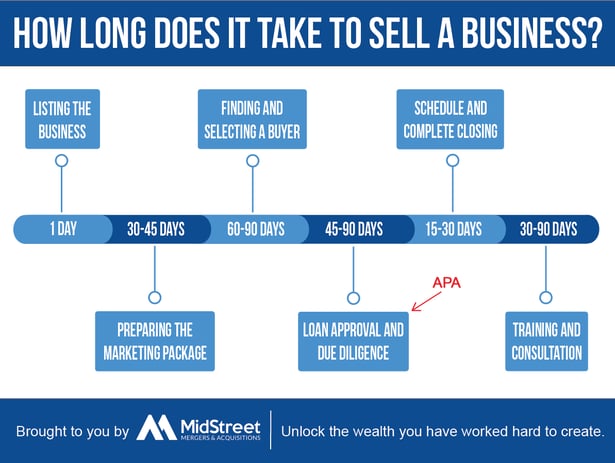What is an Asset Purchase Agreement?
The asset purchase agreement (or “APA”) is one of the single most important documents you will sign in the sale of your business.
Since it's such an important document, you might be worried about what you're signing up for.
As a mergers & acquisitions (M&A) firm that has sold over 450+ businesses, these are a few of the common questions we get from business owners.
“What if all of the details are not accounted for in my APA?”
“What if the buyer’s attorney skews the APA in their favor?”
“What if I miss something that comes back to bite me later?”
Fortunately, there is a solution.
We’ve created a guide of what you’ll need to know about the APA, from what it should include to who you should consult with when reviewing it so you can sign confidently.
Let’s get started.
Disclaimer: Although effort has been made in providing accurate information, MidStreet does not warrant that accuracy and is not liable for any errors or omissions. MidStreet, nor its employees, are licensed tax professionals or attorneys. Readers are strongly encouraged to confirm tax and legal issues with accountants and attorneys in your respective state or province. The article is based on information as of fall 2021.
What is An Asset Purchase Agreement?
An asset purchase agreement (APA) is the contract that governs the sale of your business to the buyer. It takes the terms agreed to in the LOI (letter of intent) and fleshes them out to include all the details.
All of the terms of the deal that were initially agreed upon in the LOI can be modified in the APA to reflect any changes or additions that come up during the buyer’s due diligence period.
NOTE
The LOI deals with broad terms while the APA clearly defines every detail of the transaction. A good APA will make the transaction easy to understand and serve as the final contract in the sale of the business.
At What Stage Does An Asset Purchase Agreement Come Up?
Once the letter of intent has been signed, the buyer will start their due diligence process.
During this stage, the asset purchase agreement will be drafted as things arise during due diligence and the previous terms of the LOI will be discussed, negotiated, and finalized.
Towards the end of the due diligence period, the buyer and seller will sign the APA to agree to the final terms of the asset sale.

Who Drafts the Purchase Agreement?
In general, the buyer’s attorney will draft up an asset purchase agreement and send it to the seller's attorney for review.

The seller, their merger and acquisition (M&A) advisor, and their attorney will then review the asset purchase agreement to determine whether they agree with the terms.
If the seller does not agree with the terms and would like to negotiate them, their attorney will draft up the changes and the M&A advisor will send it back to the buyer. It's common for purchase agreements to go through several revisions prior to being accepted by both parties.
What You Need to Know Before Signing an Asset Purchase Agreement
Unlike a letter of intent, an asset purchase agreement is structured to be a binding contract. Some things you should know before signing include:
- After you've had an opportunity to review the document, have your attorney thoroughly explain anything you don't understand. Pay particular attention to the "Representations and Warranties" language.
- By this point, you should have already had your accountant review the allocation of purchase price. Confirm the values are what you previously agreed to as this can have significant tax implications.
- If you do not agree with any language in the APA, your M&A advisor should work with your professional advisors to provide suggestions on alternative language or deal structures.
What Should be Included in an Asset Purchase Agreement?
As a general rule, your asset purchase agreement (APA) should cover every detail up for negotiation in the sale of your business. APA’s should include:
1. Price and Fee Allocations
This will cover the price/fees associated with the sale including the purchase price, any earnest money, the payment due at closing, buyer and seller fees, and any money to be held in escrow (often called a holdback).
2. Closing Information
This will include the date of the closing, how the possession of assets will be handled, and the closing documents.
3. Training and Transition Assistance
This portion of the agreement will cover how long the training period will be and the type of assistance that the seller will provide to the buyer.
4. Taxes, Assessments, Inventory, and Other Prorations
This will cover the taxes the buyer will be responsible for after the closing date. It likely will also go over inventory and the amount of inventory at closing.
5. Contingencies to Buyer’s Obligation to Close
These contingencies explain under what circumstances the buyer can choose to not purchase the business after signing the purchase agreement. A common buyer contingency is the ability to get a bank loan at acceptable terms.
6. Representations, Warranties, and Covenants of All Parties
Representations and warranties (often called reps and warranties) are the assertions the buyer and seller make in the transaction. Both parties expect the other to provide accurate information among other important considerations.
In a business sale, typical things the seller might assert are that they own the business and have the right to sell it or that the business is in compliance with all applicable laws.
7. Maintenance and Damage
This will cover the seller’s responsibility to maintain the assets and the company. It will also mention that the buyer will give the seller a set amount of time to fix the damage if any occurs.
8. Indemnification, Notices, and Arbitration
This will go over what the buyer and seller have indemnity on, which means they will be held harmless for certain provisions laid out and agreed upon in the APA.
9. Brokerage
This will cover the brokerage or brokerages that are involved in the transaction.
10. Authority
This goes over the undersigners that are executing the agreement for the seller and the buyer.
11. Governing Law
This will cover which state’s laws the agreement will be in accordance with.
12. Complete Agreement
This mentions that this will be the complete and final agreement between the buyer and seller for the sale of the business.
13. Execution Date and Expiration Date
This section mentions when the agreement will be executed and also specifies a date in which the agreement will be void if the transaction has not closed.
14. Disclosures
The disclosures cover reference to the law firm that assisted the buyer in drafting the agreement as well as both the buyer and seller’s right to seek counsel regarding the agreement.
15. Ongoing Operations and Confidentiality
This section states that the seller is to continue business as normal until the sale is complete and to provide written notice to the buyer if they are to change anything.
This is a condensed version of what an APA will include. To verify that the APA you have received covers all of the necessary points, speak to your attorney and broker.
Negotiate Your APA to Get the Best Deal
An asset purchase agreement will always include more information than a letter of intent, so it is key to review it to check that it contains everything you want to negotiate.
If any terms are left out of the asset purchase agreement, they will be subject to interpretation and may not even be up for negotiation.
Ensure you sign a good APA by consulting with your attorney and broker as early as possible in the process.
At MidStreet Mergers & Acquisitions, we guide business owners through each step of the selling process to get them the best deal.
Read more on the process of selling your business or contact us today to learn more about selling your business.





